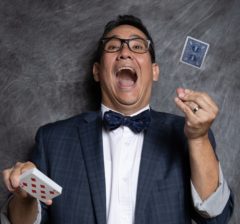A friend of mine who is a mentalist from Ireland is in town and we had coffee yesterday. We were chatting about mentalism and the struggles to make it play big. One of the things he showed me was probably the coolest thing I’ve seen this year (more on this in a minute).
Part of the challenge of mentalism is you need normal-ish looking props. Once you know make a die 24 inches big, or use a calculator that’s build for bigfoot, you lose what makes mentalism great, which is the lack of propy props.
This is where what he showed me comes in. He showed me Phil Smith’s Quinta Force.

This is an amazing way to force one object out of five that feels very free and has some theatrical build up to it as well.
My idea is to borrow five different objects from people in the audience. You introduce a padded envelope that has your prediction in it. They give you a number, let’s say it is 28. You count to that number per the Quinta Force and let’s say we end up on a cellphone. You open the envelope and inside is a cellphone…then for the kicker on the back written in marker in giant numbers is 28!
I haven’t finished reading the book, so someone may have thought of this already.
That’s something that will play fairly large, I guess it could be done with paper prediction that unfolded into a large display. My thinking was to try to get away from a printed prediction as that’s fairly common way to reveal things and I wanted something that would add some texture to the show.


